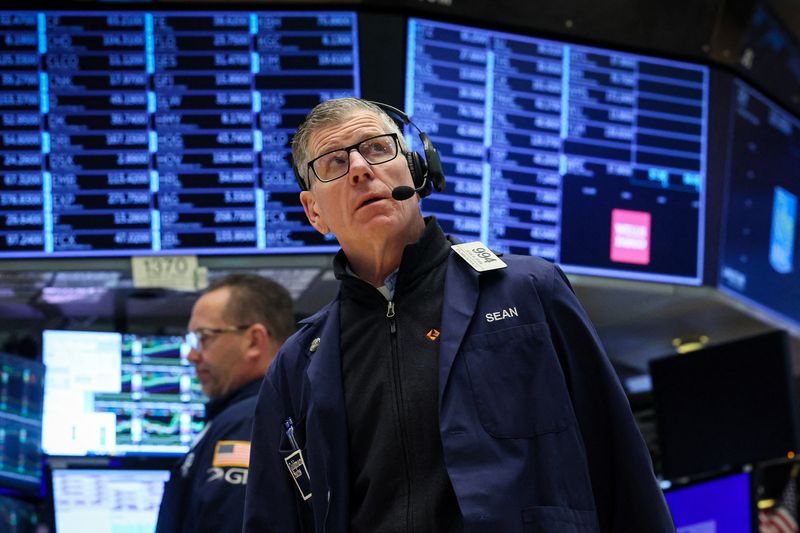Futures higher, ISM manufacturing PMI ahead – what’s moving markets

Investing.com – US stock index futures pointed up on Friday, suggesting a rebound from a negative start to the trading year on Wall Street marked by a slide in shares in electric-vehicle group Tesla (NASDAQ:TSLA). Investors are looking ahead to the release of factory activity data out of the US, which could could provide a glimpse into the state of the key manufacturing sector heading into incoming President Donald Trump’s next administration. Elsewhere, current US President Joe Biden is reportedly expected to block the sale of U.S. Steel to Japan’s Nippon Steel, the Washington Post has reported.
1. Futures higher
US stock futures edged higher on Friday, as traders assessed a downbeat start to trading in 2025 in the previous session.
By 03:19 ET (08:19 GMT), the Dow futures contract had risen by 85 points or 0.2%, S&P 500 futures had gained 19 points or 0.3%, and Nasdaq 100 futures had ticked up by 97 points or 0.5%.
The main indices on Wall Street dropped to kick off dealmaking for the new year on Thursday. The 30-stock Dow Jones Industrial Average dipped by 152 points or 0.4%, while the benchmark S&P 500 fell by 13 points or 0.2%, and the tech-heavy Nasdaq Composite shed 30 points or 0.2%.
Weighing on sentiment were shares in Tesla, which slumped by more than 6% after the electric carmaking giant reported its first annual decline in sales despite a raft of price cuts and promotional drives aimed at bolstering demand.
Meanwhile, initial and continuing claims for unemployment benefits in the US both fell last week, Labor Department data showed. The report added to some bets that the Federal Reserve will choose to leave interest rates unchanged at its next policy meeting this month.
2. ISM manufacturing PMI ahead
In a relatively quiet day for economic data, investors will have the chance to parse through US factory activity figures for December.
The Institute for Supply Management’s purchasing managers’ index for the manufacturing sector is seen cooling slightly to 48.2 last month, down from a five-month high of 48.4 in November. A reading below 50 typically denotes contraction in the industry, which makes up over 10% of the US economy.
It was the eighth consecutive month that the measure was below the 50-point threshold, although the number remained above a level of 42.5 that the ISM says indicates broader economic expansion.
Markets will likely be keen to see if the data shows both growth in orders and easing input cost contraints heading into the potentially more pro-business Trump administration. Crucially, the forward-looking new orders sub-index rose to 50.5 in November, moving into expansionary territory for the first time since March, while the reading of prices paid by manufacturers declined.
3. Biden set to block U.S. Steel sale – WaPo
US President Joe Biden has decided to block the sale of U.S. Steel to Japan’s Nippon Steel, the Washington Post reported on Thursday evening, following a year of political sparring and debate over the takeover.
CBS News had reported earlier that Biden was set to make a decision on the deal by as soon as Friday, after the Committee on Foreign Investment in the United States referred the final decision on the deal to the White House in December.
Biden has largely opposed the deal, as have several lawmakers, on the grounds that it could compromise US steel supplies. The United Steelworkers Union has also opposed the move, saying it could cut US steelmaking capacity and spark layoffs.
4. Bitcoin inches up
Bitcoin rose on Friday, extending a recovery from a price rout seen over the new year holiday as traders sought more clarity on the US regulatory outlook under incoming President Donald Trump.
Stablecoin Tether was a main point of focus this week, as it logged its worst decline in market capitalization since the 2022 FTX crash after the European Union’s Markets in Crypto-Assets law came into full effect in late-December. Several European exchanges, as well as Coinbase Global (NASDAQ:COIN) Inc, pulled the stablecoin from their platforms over compliance concerns.
Broader crypto markets were battered by a wave of selling in the final week of 2024 as traders locked in a stellar run of profits through the year. But some caution also crept into markets, especially on the notion that US interest rates will fall at a slower pace in 2025.
Still, the prospect of friendlier regulations under Trump kept crypto markets relatively upbeat, with Bitcoin also staging a recovery from its year-end lows.
5. Oil on track for weekly increase
Oil prices stabilized Friday, consolidating the prior session’s gains amid hopes of policy support to revive economic growth in China, the world’s largest crude importer.
By 03:20 ET, the US crude futures (WTI) climbed 0.1% to $73.20 a barrel, while the Brent contract rose 0.1% to $75.99 per barrel.
Both contracts closed at their highest in more than two months on Thursday, and are on track for their second weekly increase after investors returned from holidays, improving trade liquidity.
China’s President Xi Jinping pledged more proactive policies to boost growth earlier this week, while the Financial Times reported on Friday that the Chinese central bank is planning to cut interest rates from the current 1.5% level “at an appropriate time” this year.




